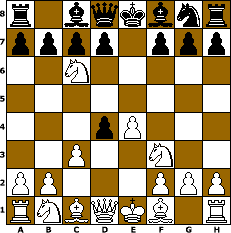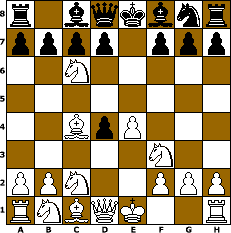The Scotch Game is a chess opening that begins with the moves
- 1.e4 e5
- 2.Nf3 Nc6
- 3.d4
The Scotch Game received its name from a correspondence match in 1824 between Edinburgh and London. Popular in the 19th century, by 1900 the Scotch had lost favor among top players because it tends to lead to early release of tension and many equalizing methods for Black are known. More recently the Scotch has regained some popularity and it has been used by grandmasters Kasparov and Timman as a surprise to avoid the well-analyzed Ruy Lopez.
White aims to dominate the center by exchanging his d-pawn for Black´s e-pawn. Black is practically forced to play 3...exd4 as he has no good way to maintain his pawn on e5 (3...d6 transposes to an inferior variation of Philidor´s Defense where White has the advantage after 4.Bb5), and 3...Nxd4? is a strategic error.
After 4.Nxd4 exd4 5.Qxd4 (5.Bc4 is the Napoleon Gambit) White´s queen stands on a central square, and is not developed too early since it cannot be chased away effectively (5...c5? is a seriously weakening move that blocks Black´s kings bishop).
After 3...exd4, White can respond with the main line 4.Nxd4 or he can play a gambit by offering Black one or two pawns in exchange for rapid development.
Main variations
  
After 1.e4 e5 2.Nf3 Nc6 3.d4 exd4, the most important continuations are
In the main line after 4. Nxd4, Black has three major options. Either 4...Bc5 or 4...Nf6 offer Black good chances for an equal game. Black can instead win a pawn with Steinitz´s move 4...Qh4, but this gives White an attack and the game might continue 4.Nb5 Qxe4+ 5.Be2 Bb4+ 6.Nc3 Bxc3+ 7.bxc3 Kd8 8.0-0 Nge7 with even chances.
On the fourth move White has two ways to offer a gambit. The Scotch Gambit starts with 4.Bc4. Black can transpose into the Two Knights Defense with 4...Nf6 or he can continue the Scotch with 4...Bc5 5.c3 and now 5...Nf6 will transpose into a safe variation of the Giuoco Piano. Black can instead accept the gambit with 5...dxc3 but this is riskier because White will gain a lead in development. A possible continuation is 6.Nxc3 d6 7.Qb3 Qd7 8.Nd5 Nge7 9.Qc3 0-0.
The Göring Gambit is a relative of the Danish Gambit that starts with 4.c3. Now transposing into the Danish with 4...d5 equalizes for Black, but he can also accept the pawn with 4...dxc3. White can then transpose into the Danish by offering a second pawn with 5.Bc4. If Black accepts the second pawn with 5...cxb2 6. Bxb2 d6, he can defend successfully after either 7.Qb3 Qd7 or 7.0-0 Be6 8.Bxe6 fxe6 9.Qb3 Qd7. To remain in the Göring proper, White recaptures with his knight with 5.Nxc3 and Black can defend with 5...Bb4 6.Bc4 d6.
|
categories: theme library | Scotch game
article No 979 / last change on 2005-07-05, 04:30pm
back write a new article show all articles
This article is based on the article Scotch Game from the free encyclopaedia
Wikipedia and stands under the
GNU-Licence for free documentation.
In the Wikipedia a list of the authors is available. |
